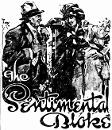5. In her interview for the 2009 DVD box set, composer Jen Anderson, indicates that she did not use jazz music as her frame of reference for the reconstructed version's soundtrack, preferring folk music instead, because jazz had not become popular in Australia by 1919. This is historically inaccurate on three counts. Firstly, the closely-related music form, ragtime (which Anderson does not refer to) had been a staple of the variety theatre stage from the early years of the twentieth century. By 1904 US ragtime songs were being included in songsters produced by Australian publishers - Albert and Sons
American Annual series, for example. Within ten years rag songs were being incorporated into every aspect of the Australia popular stage, including pantomimes, and numerous local variety composers/performers were having their own songs published - including for example,
Tommy Armstrong,
Vince Courtney and
Nat Phillips (aka Stiffy, of
Stiffy and Mo fame). Ragtime's popularity began to decline by the late 1910s/early 1920s in response to jazz (namely dixieland). The second issue, relates to the introduction and almost immediate success of jazz in Australia. After being introduced to variety audiences in 1918, advertisements quickly began appearing in newspapers and trade magazines around the country promoting not only the music, but also dancing (including lessons). The speed at which jazz arrived in this country via the international variety circuit is noted by Andrew Bissett who writes: 'Sydney may have heard [New Orleans] jazz before Chicago' (p. 1). The third issue relating to the music of the era is the lack of evidence supporting any claim that folk was the music of the popular (or working-class) culture. Extensive research conducted by Dr Clay Djubal into Australian variety theatre during the 1910s has so far failed to find any mention of folk music (or traditional bush ballads) being performed. This is because variety theatre was based on popular culture production - which is itself reliant on new or latest styles and fashions. Folk music, even in the 1910s and 1920s, therefore had no currency with the contemporary audience. [sources: Clay Djubal, 'What Oh Tonight,' pp. 250-261 ; and Andrew Bissett Black Roots, White Flowers, pp. 1-9]
 8446372745420830197.jpg
8446372745420830197.jpg


